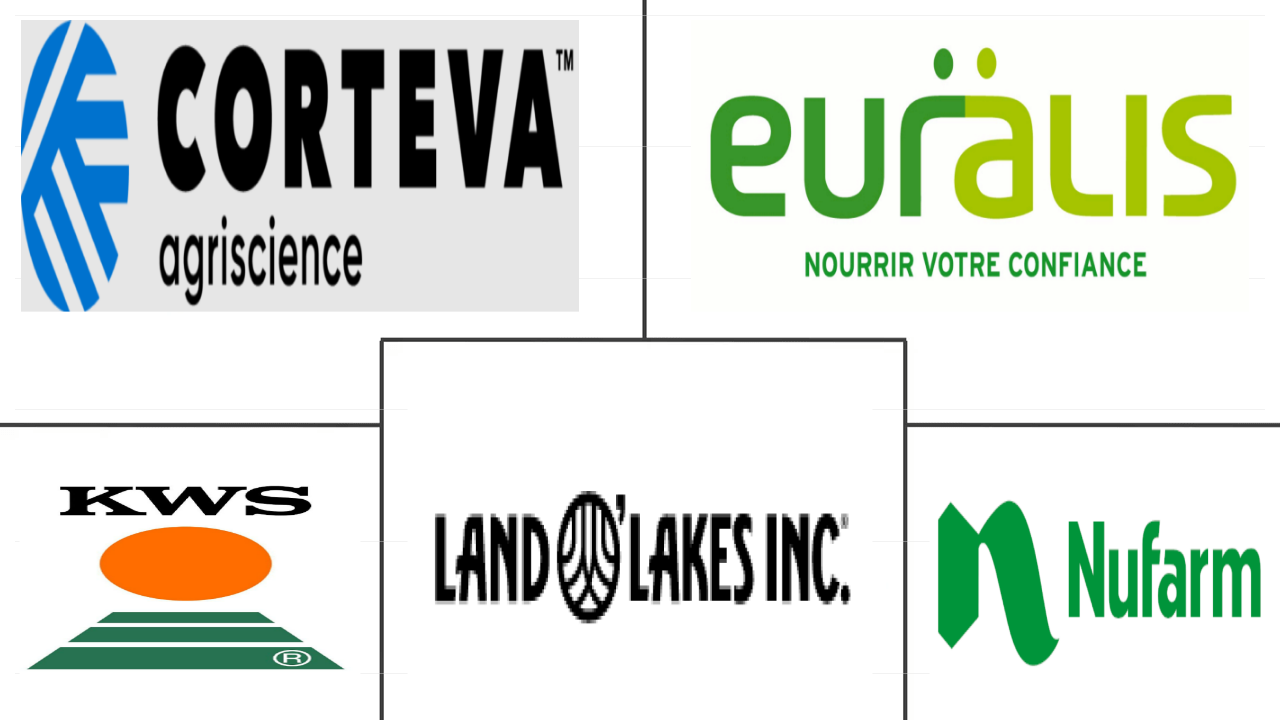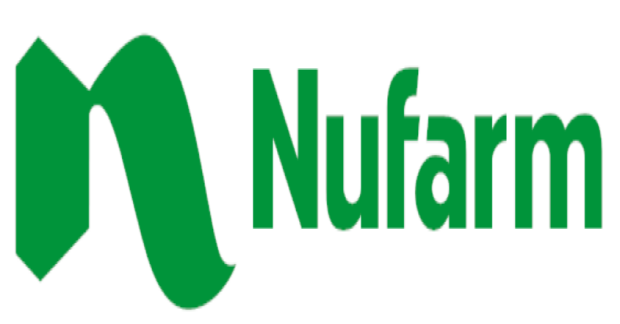Market Size of sunflower seed (seed for sowing) Industry
|
|
Study Period | 2017 - 2030 |
|
|
Market Size (2024) | USD 1.09 Billion |
|
|
Market Size (2030) | USD 1.52 Billion |
|
|
Largest Share by Breeding Technology | Hybrids |
|
|
CAGR (2024 - 2030) | 5.65 % |
|
|
Largest Share by Region | Europe |
Major Players |
||

|
||
|
*Disclaimer: Major Players sorted in no particular order |
Sunflower Seed (seed For Sowing) Market Analysis
The Sunflower Seed (seed For Sowing) Market size is estimated at 1.09 billion USD in 2024, and is expected to reach 1.52 billion USD by 2030, growing at a CAGR of 5.65% during the forecast period (2024-2030).
1.09 Billion
Market Size in 2024 (USD)
1.52 Billion
Market Size in 2030 (USD)
4.48 %
CAGR (2017-2023)
5.65 %
CAGR (2024-2030)
Largest Market by Breeding Technology
90.98 %
value share, Hybrids, 2023
There was an increase in the demand for hybrid seeds due to the rise in the cultivation area under hybrid seeds and the availability of improved hybrid seed varieties.
Largest Market by Country
25.97 %
value share, Argentina, 2023
The driving factors for Argentina to cultivate sunflowers include the increased demand after the Ukraine-Russia war, high ROI, and the availability of advanced traits.
Fastest-growing Market by Breeding Technology
5.73 %
Projected CAGR, Hybrids, 2024-2030
Major companies are developing new hybrids. The adoption of hybrids is high due to drought tolerance, disease resistance, high yield, and wider adaptability.
Fastest-growing Market by Country
13.58 %
Projected CAGR, Poland, 2024-2030
The county is expected to witness growth due to an increase in cultivated area. The government is encouraging the growers to grow more sunflowers to lower their dependence on imports.
Leading Market Player
15.25 %
market share, Nufarm, 2022

The company is the market leader because it invested to expand its operations in Europe and increase the production capacity of sunflower seeds that will be supplied globally.
Hybrids held the major share due to higher yield, pest resistance, and high oil content
- In 2022, hybrid seeds had more share than open-pollinated seed varieties because hybrid seeds are drought resistant, have wider adaptability to different regions and weather conditions, and high-quality oil seeds are produced by using hybrid seeds.
- During the forecast period, the hybrid segment is projected to register a CAGR of 5.7% due to its ability to provide higher yield and pest resistance. Globally, in 2022, the non-transgenic hybrid sunflower seed market was about 100% of the sunflower hybrid seed market. Transgenic sunflowers are not cultivated commercially, and the awareness among people about the benefits of consuming non-GMO food is increasing. Thus, the demand for non-transgenic hybrids is increasing.
- In most regions, open-pollinated seed varieties are used less compared to hybrid seed varieties because open-pollinated seed varieties are not resistant to diseases and can be attacked easily by both biotic and abiotic factors. Therefore, to minimize crop loss due to weeds and insects, growers use hybrid seed traits such as disease tolerance and insect resistance.
- Open-pollinated seed varieties are anticipated to register a CAGR of 3.4% during the forecast period owing to a steady increase in sowing under OPVs because small-scale growers prefer to use open-pollinated seed varieties as they are less expensive than hybrid seeds and easily adapt to local conditions.
- Therefore, the benefits, such as higher yield and resistance to diseases, will help drive the hybrid seed segment, but open-pollinated seed varieties will be used by small-scale farmers for higher profit by minimizing crop input costs.
Hybrids are the fastest-growing segment in the global sunflower seed market due to their ability to resist inclined climatic conditions and provide high yields
- South America is one of the top producers of sunflowers globally. In 2022, it held a market share of 29.1% in the global sunflower seed market value. This is because sunflowers produced in South America have high export value and are processed for oil and oil mixes. Additionally, the seed companies in the region have released new seed hybrids that are focused on high oil content and suiting processing industries.
- In South America, the cultivated area for sunflowers was 1.9 million hectares in 2022, which increased by 8.7% between 2020 and 2022 due to an increase in demand for oil and processed foods.
- There is a growing production demand for sunflower and its oil in Argentina due to the Russia-Ukraine War, as they are the largest producers and exporters of sunflower products globally.
- Europe is a region that is estimated to witness growth, registering a CAGR of about 6.2% during the forecast period due to the availability of advanced technology. According to the USDA, Europe has ideal weather conditions, due to which the production of sunflowers is expected to increase during the forecast period.
- Asia-Pacific has the second-largest cultivated area of sunflowers across the world, with 2.5 million ha in 2022, which is estimated to increase further due to rising prices and demand for sunflower seeds.
- Hybrid seeds used for the cultivation of sunflowers are expected to register a CAGR of 5.7% during the forecast period, as the sunflower crop is more vulnerable to climatic conditions, and hybrid varieties have the ability to resist inclined climatic conditions such as drought and flood.
- Therefore, the increasing cultivation areas and the high demand for sunflower oil may help boost the growth of the sunflower segment during the forecast period.
Sunflower Seed (seed For Sowing) Industry Segmentation
Hybrids, Open Pollinated Varieties & Hybrid Derivatives are covered as segments by Breeding Technology. Africa, Asia-Pacific, Europe, Middle East, North America, South America are covered as segments by Region.
- In 2022, hybrid seeds had more share than open-pollinated seed varieties because hybrid seeds are drought resistant, have wider adaptability to different regions and weather conditions, and high-quality oil seeds are produced by using hybrid seeds.
- During the forecast period, the hybrid segment is projected to register a CAGR of 5.7% due to its ability to provide higher yield and pest resistance. Globally, in 2022, the non-transgenic hybrid sunflower seed market was about 100% of the sunflower hybrid seed market. Transgenic sunflowers are not cultivated commercially, and the awareness among people about the benefits of consuming non-GMO food is increasing. Thus, the demand for non-transgenic hybrids is increasing.
- In most regions, open-pollinated seed varieties are used less compared to hybrid seed varieties because open-pollinated seed varieties are not resistant to diseases and can be attacked easily by both biotic and abiotic factors. Therefore, to minimize crop loss due to weeds and insects, growers use hybrid seed traits such as disease tolerance and insect resistance.
- Open-pollinated seed varieties are anticipated to register a CAGR of 3.4% during the forecast period owing to a steady increase in sowing under OPVs because small-scale growers prefer to use open-pollinated seed varieties as they are less expensive than hybrid seeds and easily adapt to local conditions.
- Therefore, the benefits, such as higher yield and resistance to diseases, will help drive the hybrid seed segment, but open-pollinated seed varieties will be used by small-scale farmers for higher profit by minimizing crop input costs.
| Breeding Technology | |||
| |||
| Open Pollinated Varieties & Hybrid Derivatives |
| Region | |||||||||||||||||
| |||||||||||||||||
| |||||||||||||||||
| |||||||||||||||||
| |||||||||||||||||
| |||||||||||||||||
|
Sunflower Seed (seed For Sowing) Market Size Summary
The sunflower seed market for sowing is poised for significant growth, driven by the increasing demand for hybrid seeds, which offer advantages such as drought resistance, pest resistance, and higher yields. Hybrid seeds are gaining traction due to their adaptability to various climatic conditions and their ability to produce high-quality oil seeds. This trend is particularly pronounced in regions like South America, where sunflower production is bolstered by favorable export conditions and the introduction of new seed hybrids. The market is also witnessing a steady demand for open-pollinated seed varieties, especially among small-scale farmers who prefer these due to their lower costs and adaptability to local conditions. However, the overall preference leans towards hybrid seeds, which are seen as a solution to minimize crop losses from biotic and abiotic factors.
Globally, the sunflower seed market is experiencing a shift towards non-transgenic hybrids, aligning with the growing consumer awareness and preference for non-GMO foods. Regions such as Europe and Asia-Pacific are expected to see increased cultivation areas, supported by advanced agricultural technologies and rising demand for sunflower oil. The market is moderately consolidated, with major players like Corteva Agriscience and Syngenta AG leading the charge in developing seed varieties with improved traits such as disease resistance and high oil content. The ongoing geopolitical tensions, such as the Russia-Ukraine war, are also influencing production dynamics, particularly in Argentina, a key player in the sunflower market. As the demand for sunflower oil rises, driven by the increasing prices of alternative oils like soybean and palm oil, the sunflower seed market is set to expand, offering higher income returns to growers.
Sunflower Seed (seed For Sowing) Market Size - Table of Contents
-
1. MARKET SEGMENTATION (includes market size in Value in USD, Forecasts up to 2030 and analysis of growth prospects)
-
1.1 Breeding Technology
-
1.1.1 Hybrids
-
1.1.1.1 Non-Transgenic Hybrids
-
-
1.1.2 Open Pollinated Varieties & Hybrid Derivatives
-
-
1.2 Region
-
1.2.1 Africa
-
1.2.1.1 By Breeding Technology
-
1.2.1.2 By Country
-
1.2.1.2.1 Egypt
-
1.2.1.2.2 Ethiopia
-
1.2.1.2.3 Ghana
-
1.2.1.2.4 Kenya
-
1.2.1.2.5 Nigeria
-
1.2.1.2.6 South Africa
-
1.2.1.2.7 Tanzania
-
1.2.1.2.8 Rest of Africa
-
-
-
1.2.2 Asia-Pacific
-
1.2.2.1 By Breeding Technology
-
1.2.2.2 By Country
-
1.2.2.2.1 Australia
-
1.2.2.2.2 Bangladesh
-
1.2.2.2.3 China
-
1.2.2.2.4 India
-
1.2.2.2.5 Indonesia
-
1.2.2.2.6 Myanmar
-
1.2.2.2.7 Pakistan
-
1.2.2.2.8 Thailand
-
1.2.2.2.9 Rest of Asia-Pacific
-
-
-
1.2.3 Europe
-
1.2.3.1 By Breeding Technology
-
1.2.3.2 By Country
-
1.2.3.2.1 France
-
1.2.3.2.2 Germany
-
1.2.3.2.3 Italy
-
1.2.3.2.4 Netherlands
-
1.2.3.2.5 Poland
-
1.2.3.2.6 Romania
-
1.2.3.2.7 Russia
-
1.2.3.2.8 Spain
-
1.2.3.2.9 Turkey
-
1.2.3.2.10 Ukraine
-
1.2.3.2.11 United Kingdom
-
1.2.3.2.12 Rest of Europe
-
-
-
1.2.4 Middle East
-
1.2.4.1 By Breeding Technology
-
1.2.4.2 By Country
-
1.2.4.2.1 Iran
-
1.2.4.2.2 Rest of Middle East
-
-
-
1.2.5 North America
-
1.2.5.1 By Breeding Technology
-
1.2.5.2 By Country
-
1.2.5.2.1 Canada
-
1.2.5.2.2 Mexico
-
1.2.5.2.3 United States
-
-
-
1.2.6 South America
-
1.2.6.1 By Breeding Technology
-
1.2.6.2 By Country
-
1.2.6.2.1 Argentina
-
1.2.6.2.2 Brazil
-
1.2.6.2.3 Rest of South America
-
-
-
-
Sunflower Seed (seed For Sowing) Market Size FAQs
How big is the Global Sunflower Seed (seed For Sowing) Market?
The Global Sunflower Seed (seed For Sowing) Market size is expected to reach USD 1.09 billion in 2024 and grow at a CAGR of 5.65% to reach USD 1.52 billion by 2030.
What is the current Global Sunflower Seed (seed For Sowing) Market size?
In 2024, the Global Sunflower Seed (seed For Sowing) Market size is expected to reach USD 1.09 billion.

